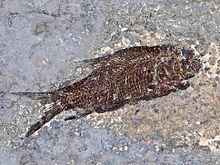Jianghanichthys is an extinct genus of freshwater cypriniform fish from the Late Paleocene to Early Eocene of central and southern China, and the only member of the family Jianghanichthyidae.[1] It is the oldest cypriniform fish known from body fossils, and the most basal known cypriniform.[2][3]
| Jianghanichthys Temporal range:
| |
|---|---|

| |
| Fossil of J. hubeiensis from China | |
| Scientific classification | |
| Domain: | Eukaryota |
| Kingdom: | Animalia |
| Phylum: | Chordata |
| Class: | Actinopterygii |
| Order: | Cypriniformes |
| Family: | †Jianghanichthyidae Liu, Chang, Wilson & Murray, 2015 |
| Genus: | †Jianghanichthys Lei, 1987 |
| Type species | |
| †Osteochilus hubeiensis Lei, 1977
| |
| Species | |
| |
The genus name Jianghanichthys derives from "Jianghan", the place where the first fossil remains of J. hubeiensis were found, and "ichthys" derives from the Greek word for 'fish'.[1] It is also known as the "Chan Han fish" in the fossil trade.[4]
Taxonomy
editTwo species are known, both of which were previously placed in Osteochilus:
- †J. hubeiensis (Lei, 1977) - Early Eocene (Ypresian) of Hubei, China (Yangxi Formation)[1][5]
- †J. sanshuiensis (Li & Wang, 1979) - Late Paleocene (Thanetian) and Ypresian of Guangdong, China (Buxin Formation) (=Osteochilus laticorpus Li & Wang, 1979, O. longipinnatus Li & Wang, 1979)[3]
There are still disagreements as to the scientific classification, name and age of this genus. However the body shape of Jianghanichthys differs from that of all Amyzon species. J. hubeiensis was reclassified from Osteochilus into the new genus Jianghanichthys in 1987, and in 2015 it was moved from the Catostomidae to the new, basal family Jianghanichthyidae.[1] In 2024, the slightly older species J. sanshuiensis was also reclassified into this genus from Osteochilus, marking both a slight temporal extension and a range extension for the genus.[3]
Distribution
editThese fishes lived in the early Paleogene period. Fossils of Jianghanichthys have been found in Hubei and Guangdong, China.[1][3]
Fossils of J. hubeiensis are quite common and can be found in most shops.[where?] Most of these are among the thousands of well-preserved J. hubeiensis fossils which were discovered in an outcrop in a farm near Songzi in the 1980s. However, overcollection by commercial fossil collectors had destroyed this locality by 2005, though some new specimens have since been discovered with later fieldwork.[1]
References
edit- Organism Names
- Enciclopaedia of Life
- Fish, Reptilia & Mammalia. Biostratigraphy of the Yangtze Gorge area. Volume 5. Cretaceous and Tertiary., Geological Publishing House, Beijing, 1987: 133–187. Chapter pagination: 187–200. Zoological Record Volume 127
- Juan Liu, Mee-mann Chang A new Eocene catostomid (Teleostei: Cypriniformes) from northeastern China and early divergence of Catostomidae
- Universal Biological Indexer
- LIU Juan, TSENG Zhijie J., WILSON Mark V., MURRAY Alison M. - ASIAN FOSSIL CATOSTOMIDS AND ONTOGENETC CHANGE IN EARLY CYPRINIFORMS
- Specific
- ^ a b c d e f Liu, Juan; Chang, Mee-Mann; Wilson, Mark V. H.; Murray, Alison M. (2015-11-02). "A new family of Cypriniformes (Teleostei, Ostariophysi) based on a redescription of † Jianghanichthys hubeiensis (Lei, 1977) from the Eocene Yangxi Formation of China". Journal of Vertebrate Paleontology. 35 (6): e1004073. doi:10.1080/02724634.2015.1004073. ISSN 0272-4634.
- ^ Near, Thomas J.; Thacker, Christine E. (2024-04-18). "Phylogenetic Classification of Living and Fossil Ray-Finned Fishes (Actinopterygii)". Bulletin of the Peabody Museum of Natural History. 65 (1). doi:10.3374/014.065.0101. ISSN 0079-032X.
- ^ a b c d Liu, Juan; Chang, Meemann; Zhang, Jiangyong; Chen, Gengjiao; Shi, Chaofan (2024-05-09). "Taxonomic revision and type specimens' location of jianghanichthyids (Ostariophysii: Cypriniformes) from Buxin Formation, Sanshui Basin, China". Journal of Vertebrate Paleontology. doi:10.1080/02724634.2024.2342857. ISSN 0272-4634.
- ^ "Bob Gillham collection | Earth Sciences Museum". uwaterloo.ca. Retrieved 2024-01-22.
- ^ "Yangxi Formation". chinalex.geolex.org. Retrieved 2024-07-27.